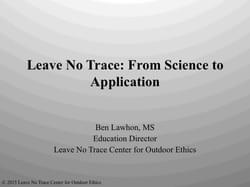




From Science to Application
Leave No Trace educational techniques.

Presenter: Ben Lawhon, Education Director, Leave No Trace Center for Outdoor Ethics
Leave No Trace has become a prominent educational technique used to curb inappropriate or depreciative behaviors amongst park and protected area visitors. Over the past 15 years, much of the research on Leave No Trace has focused on recreation ecology and the ecological importance of Leave No Trace principles: What are the best ways to convey Leave No Trace principles to visitors? What are the most effective messages used to alter visitor behavior? How effective do visitors think Leave No Trace Principles are in curbing impacts?